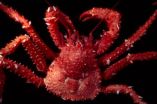Scientists uncover a genetic switch that turns immune responses on and off
New research in yhe FASEB Journal suggests that a novel negative regulator called eye transformer impacts JAK/STAT-signaling pathway response with microbial challenge in fruit flies
2010-11-02
(Press-News.org) Scientists are keeping their eye on a new discovery published in the November 2011 print issue of the FASEB Journal (http://www.fasebj.org) that explains what causes some genes to go out of control. Scientists have identified a "cellular switch," called eye transformer, that controls the flow of information from chemical signals outside of the cell to genes in the cell nucleus. This study demonstrates that when eye transformer is turned off, the information pathway it controls (the "JAK/STAT pathway") hyper-activates. Because this pathway exists in humans and is involved in many conditions such as cancer, severe immune deficiencies, autoimmune diseases, and allergies, this discovery reveals a new and potentially important drug target for these conditions.
"We hope that our study will open new horizons for researchers studying mammalian JAK/STAT signaling which eventually leads to better understanding how mammalian JAK/STAT signaling is regulated," said Mika Rämet, Ph.D., co-author of the study from the Institute of Medical Technology at the University of Tampere in Finland. "We hope that this information can be then used in developing better treatments for diseases that are influenced by malfunctioning JAK/STAT signaling."
To make this discovery, Rämet and colleagues "silenced" all of the fruit fly genes one by one using RNAi-based screening methods in cultured Drosophila (fruit fly) cells and then analyzed which genes were important for JAK/STAT signaling. They identified five novel regulators, one of which was a negative regulator of eye transformer that proved to negatively regulate the JAK/STAT response during microbial challenge. Further research showed that suppression of eye transformer expression in the eyes of fruit flies by in vivo RNAi causes hyper-activation of JAK/STAT signaling indicated by drastic eye overgrowth when JAK/STAT signaling was activated.
"We tend to treat immune diseases after the inflammation switch has been turned on," said Gerald Weissmann, M.D., Editor-in-Chief of the FASEB Journal and a past president of the American College of Rheumatology. "This study sheds new light on how we might to control diseases like rheumatoid arthritis or lupus by keeping our hands on the switch."
###
Receive monthly highlights from the FASEB Journal by e-mail. Sign up at http://www.faseb.org/fjupdate.aspx. The FASEB Journal (http://www.fasebj.org) is published by the Federation of the American Societies for Experimental Biology (FASEB). The journal has been recognized by the Special Libraries Association as one of the top 100 most influential biomedical journals of the past century and is the most cited biology journal worldwide according to the Institute for Scientific Information.
FASEB comprises 23 societies with more than 100,000 members, making it the largest coalition of biomedical research associations in the United States. FASEB enhances the ability of scientists and engineers to improve—through their research—the health, well-being and productivity of all people. FASEB's mission is to advance health and welfare by promoting progress and education in biological and biomedical sciences through service to our member societies and collaborative advocacy.
Details:Jenni Kallio, Henna Myllymäki, Juha Grönholm, Morag Armstrong, Leena-Maija Vanha-aho, Leena Mäkinen, Olli Silvennoinen, Susanna Valanne, and Mika Rämet
Eye transformer is a negative regulator of Drosophila JAK/STAT signaling. FASEB J. 2010 24: 4467-4479. DOI: 10.1096/fj.10-162784 ; http://www.fasebj.org/cgi/content/abstract/24/11/4467
END
ELSE PRESS RELEASES FROM THIS DATE:
2010-11-02
ROCHESTER, Minn. -- Statistics from the Centers for Disease Control and Prevention (CDC) (http://www.cdc.gov/) rank mortality related to chronic liver disease and cirrhosis as the 12th most common cause of death in adults in the U.S. Using a modified definition that includes diseases such as viral hepatitis, liver cancer (http://www.mayoclinic.org/liver-cancer/) and obesity-related fatty liver disease (liver diseases)(http://www.mayoclinic.org/liver-disease/), Mayo Clinic-led researchers have found that liver-related mortality is as high as fourth for some age groups, and ...
2010-11-02
Tampa, Fla. (Nov. 01, 2010) – When researchers tested three different labeling agents on three different stem cell populations to determine what effect the labeling agents had on stem cell phenotype, biological behavior and migration abilities, they found changes in stem cell proliferation depending on the type of contrast agent used.
The team of researchers from Belgium and Spain tested USPIO (ultra small superparamagnetic iron oxide) contrast agents Resovist ®, Endorem ® and Sinerem ® on mouse embryonic stem cells (mESC), rat multipotent adult progenitor cells (rMAPC) ...
2010-11-02
While wind energy has shown strong potential as a large-scale, emission-free energy source, bat and bird collisions at wind turbines result in thousands of fatalities annually. Migratory bats, such as the hoary bat, are especially at risk for collision with wind turbines as they fly their routes in the forested ridges of the eastern U.S. This loss not only impacts the immediate area, but is also detrimental to ecosystem health nationwide—that is, bats help with pest management, pollination and the dispersal of numerous plant seeds.
Since turbine towers and non-spinning ...
2010-11-02
With a lifelong interest in politics, University of Cincinnati researcher Muer Yang spent the last two years developing a quantitative method for allocating voting machines that could significantly reduce the average wait time of voters.
During the 2004 U.S. presidential elections, some voters waited in lines for more than 10 hours to cast their ballots, and in Ohio, the last vote was cast at 4 a.m., noted Ohio Secretary of State Jennifer Brunner in a public report. Ohio lines in the '06 and '08 elections were still so lengthy that they essentially "disenfranchised" voters ...
2010-11-02
CAMBRIDGE, Mass., Nov. 1, 2010 -- Race may not be as important as previously thought in determining who befriends whom, suggests a new study of American college students' habits on Facebook. The findings, by a pair of sociologists from Harvard University and UCLA, appear in the current issue of the American Journal of Sociology.
The strongest attraction, the researchers found, turned out to be old-fashioned social pressure. For the average student, the tendency to reciprocate a friendly overture is seven times stronger than the attraction of a shared racial background.
"We ...
2010-11-02
Invasions of voracious predatory crabs due to global warming could threaten the unique continental-shelf ecosystems of Antarctica, according to newly published findings.
"King crabs are ecologically important predators and form the basis of economically significant commercial fisheries," said Dr Sven Thatje, an evolutionary ecologist at the University of Southampton's School of Ocean and Earth Science (SOES), which is based at the National Oceanography Centre in Southampton.
Thatje and graduate student Sally Hall studied how water temperature influences the distributions ...
2010-11-02
THE HAGUE (2 November 2010)—A unique acacia known as a "fertilizer tree" has typically led to a doubling or tripling of maize yields in smallholder agriculture in Zambia and Malawi, according to evidence presented at a conference in the Hague today. The findings were central to the arguments of agroforestry experts at the conference, who urged decision makers to spread this technology more widely throughout the African nations most vulnerable to climate change and food shortages, and to think differently about more practical ways to solve the problems that are most pressing ...
2010-11-02
CHAMPAIGN, lll.— Ignoring topography, efficiency, expense and even their own surveyors' recommendations, regional railroad officials in the mid-19th century diverted a new rail line around New Philadelphia, Ill., "the first town in the United States planned, platted and legally registered by an African American," a University of Illinois researcher reports. The bypass pushed what would have been a fairly straight, even run of railroad tracks from Griggsville, Ill. to Hannibal, Mo., in a wide, hilly arc around New Philadelphia.
The findings, reported in Historical Archaeology, ...
2010-11-02
While simple falls, such as slipping while walking off a curb, may seem relatively harmless, they can actually lead to severe injury and death in elderly individuals, according to a new study published in The Journal of Trauma: Injury, Infection, and Critical Care. As the population continues to age, it is important for physicians and caregivers to be aware of and prepared to deal with this issue, which could significantly impact the overall health and wellbeing of older adults.
In contrast to falls from greater heights, ground-level falls – essentially falls from a ...
2010-11-02
WASHINGTON, Nov. 1, 2010 — Generations of Moms and Grandmas have preached the virtues of not wasting food. Now scientists are reporting a compelling new reason to follow this advice: It could save enormous amounts of energy, according to the latest episode in the American Chemical Society's (ACS) award-winning podcast series, "Global Challenges/Chemistry Solutions." They say that the United States could immediately save the energy equivalent of about 350 million barrels of oil a year — without spending a penny or putting a ding in the quality of life: Just stop wasting ...
LAST 30 PRESS RELEASES:
[Press-News.org] Scientists uncover a genetic switch that turns immune responses on and off
New research in yhe FASEB Journal suggests that a novel negative regulator called eye transformer impacts JAK/STAT-signaling pathway response with microbial challenge in fruit flies


